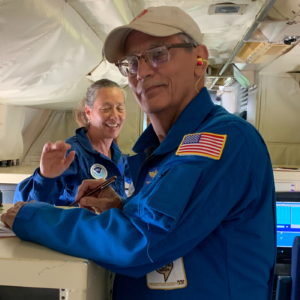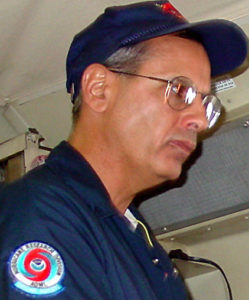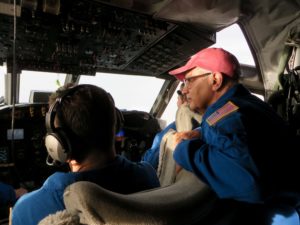Ira Pastor, ideaXme life sciences ambassador and founder of Bioquark interviews Dr. Frank D. Marks, MS, ScD, Director of Hurricane Research Division, at NOAA.

Hurricanes and climate disasters
Ira Pastor comments: Weather and climate disasters affect the world’s population.
The total approximate cost of damages from weather and climate disasters in the U.S. alone from 1980 to 2019, is over $1.75 trillion, and a major component of that damage results from hurricanes. Few things in nature can compare to the destructive force of a hurricane. Called the “Greatest Storm On Earth”, a hurricane is capable of annihilating coastal areas with sustained winds of 155 miles per hour or higher, intense areas of rainfall, and a storm surge. In fact, during it’s life cycle a hurricane can expend as much energy as 10,000 nuclear bombs! The National Oceanic and Atmospheric Administration (NOAA) is an American scientific agency, within the United States Department of Commerce, that focuses on the conditions of the oceans, major waterways, and the atmosphere. NOAA warns of dangerous weather, charts seas, guides the use and protection of ocean and coastal resources, and conducts research to provide the understanding and improve stewardship of the environment.
Dr Frank D Marks, Director Hurricane Research Division NOAA

Dr. Frank D. Marks, is Director of Hurricane Research Division, at NOAA: Dr. Marks is a recognized expert in tropical cyclones and is the leader of the NOAA tropical cyclone research efforts as the research lead of NOAA is Hurricane Forecast Improvement Project (HFIP) and the director of the Hurricane Research Division of NOAA Atlantic Oceanographic and Meteorology Laboratory. Dr. Marks also serves as co-lead of the NOAA Office of the Federal Coordinator for Meteorological Services and Supporting Research (OFCM) Working Group for Tropical Cyclone Research (WG/TCR). His research interests include analyzing meteorological remote sensing (e.g., microwave radar and radiometer) and numerical model data sets, particularly in tropical cyclones and mesoscale convective systems to understand the storm kinematic and precipitation structure. Besides his role within NOAA Dr. Marks is also an Adjunct Professor in the Department of Meteorology and Physical Oceanography at the University of Miami, as well as a Fellow of the Cooperative Institute for Marine and Atmospheric Studies (CIMAS) at the University of Miami Rosenstiel School for Marine and Atmospheric Sciences. Dr. Marks received a B.S. in Meteorology from Belknap College (1973) and both an M.S. (1975) and Sc.D. (1981) in Meteorology from the Massachusetts Institute of Technology (MIT). Dr. Marks is a member of the American Meteorlogical Society (AMS) and became a Fellow of the AMS in 2000. He served as a member of AMS Committee on Radar Meteorology and of the AMS Council.

Hurricane Hunters, Hurricane Research, Forecasting and Risk Reduction
On this ideaXme episode we will hear from Dr. Marks about: – His background – how he became interested in science, in meteorology, in hurricane research, and a little bit of his career journey through the academic and government sectors to date – A general introduction to NOAA and specifically the Hurricane Research Division – A discussion of core research priorities of the Hurricane Research Division – Technological developments that Dr. Marks is personally most excited about looking forward over the next decade or two, such as artificial intelligence/ machine learning in the forecasting process – The SUSTAIN lab or the “Surge Structure Atmosphere Interaction” lab – University of Miami US$45 million initiative to produce hurricanes up to a category 5 level (the strongest there is), with wind speeds reaching more than 252 km/h (157 mph). – This history of NOAA attempts to “stop a hurricane in its track” and Project STORMFURY – His experiences with flying into a hurricane on the NOAA Hurricane Hunter aircrafts
If you enjoyed this interview, you might also like ideaXme’s interview with Dr Tara O’Toole Senior Fellow and Vice President In-Q-Tel
Credits: Ira Pastor, ideaXme ambassador interview.

Contact the founder of ideaXme: [email protected]
Follow ideaXme on Twitter:@ideaxm On Instagram:@ideaxme
To discuss collaboration and or partnerships please contact the founder of ideaXme: [email protected]
This interview is in American English.
Find ideaXme across the internet including on Apple Podcasts, SoundCloud,Radio Public,TuneIn Radio,I Heart Radio, Google Podcasts, Spotify, Amazon Podcasts and more.
ideaXme is a global podcast, creator series and mentor programme. Our mission: Move the human story forward!™ ideaXme Ltd.


Pingback: Hurricanes: Evolution, Risk Reduction, Tracking And Simulation - AI Summary